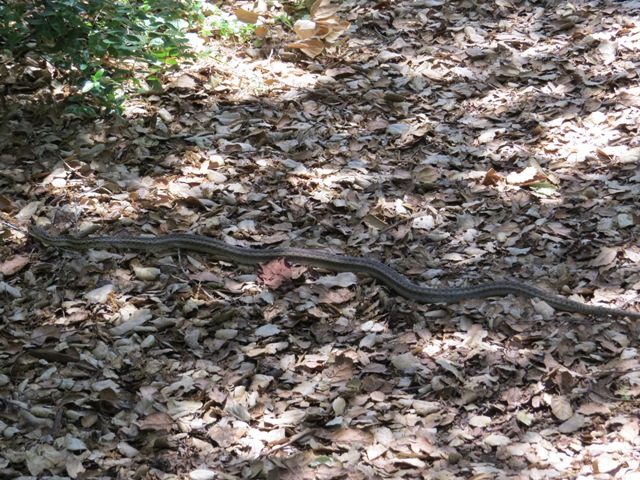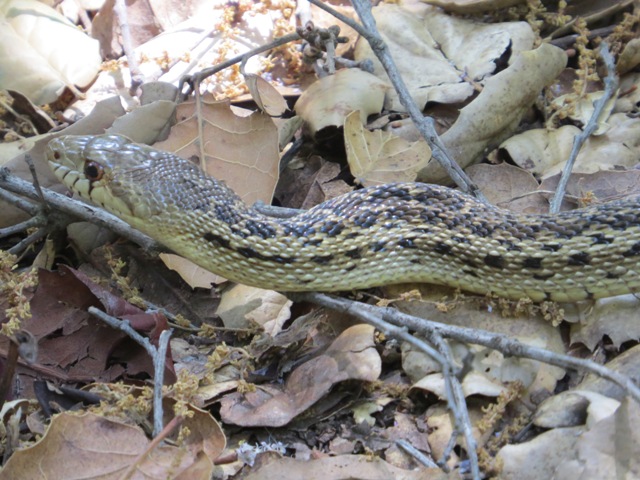This is the rare case when I saw the snake before it saw me. Are there gopher snakes in the UK? I would think not because their peculiar behavior seems adapted to the US. This Pacific Gopher Snake (Pituophis catenifer) is five feet long:

The coloration of this one is unusual to my eye. I was 200 miles south of my home territory and this snake looks a bit darker than the ones near me.

Gopher snakes are constrictors that eat rodents, birds, eggs, insects and smaller reptiles. They are diurnal, so it is not uncommon to see them. I routinely notice them in grassland, mixed forest, and chaparral.
One of the most fascinating things about this snake is its defensive behavior. It looks very much like our venomous rattlesnakes. When it feels threatened, it becomes the master of impersonation. It coils like a rattlesnake and flattens its head to look like the pit viper. But that is not all! It shakes its tail back and forth to mimic the rattlesnake. The tail may rub on leaves to create a buzzing sound. The snake also hisses at an unusually loud volume. This hiss sounds much like the buzz of a rattlesnake. This snake would make a terrific poker player!
How can I tell that it is a gopher snake and not a venomous rattlesnake? The pupil in the eye is round and a “mask” runs across its forehead between its eyes, like a raccoon’s. It is just barely visible in the close-up picture.
What I find intriguing about this snake is its behavior. I can picture how the color adaptation would evolve over time. Snakes looking like rattlers would not be predated as often. But I can’t fathom how the behavioral mimicry evolved. What mechanism produces a snake that can mimic another so perfectly? It’s not like this snake graduated university. I find it simply amazing.
Are there snakes like this in the UK? Are there similar examples near you of behavioral mimicry?
- Woodsorrel

The coloration of this one is unusual to my eye. I was 200 miles south of my home territory and this snake looks a bit darker than the ones near me.

Gopher snakes are constrictors that eat rodents, birds, eggs, insects and smaller reptiles. They are diurnal, so it is not uncommon to see them. I routinely notice them in grassland, mixed forest, and chaparral.
One of the most fascinating things about this snake is its defensive behavior. It looks very much like our venomous rattlesnakes. When it feels threatened, it becomes the master of impersonation. It coils like a rattlesnake and flattens its head to look like the pit viper. But that is not all! It shakes its tail back and forth to mimic the rattlesnake. The tail may rub on leaves to create a buzzing sound. The snake also hisses at an unusually loud volume. This hiss sounds much like the buzz of a rattlesnake. This snake would make a terrific poker player!
How can I tell that it is a gopher snake and not a venomous rattlesnake? The pupil in the eye is round and a “mask” runs across its forehead between its eyes, like a raccoon’s. It is just barely visible in the close-up picture.
What I find intriguing about this snake is its behavior. I can picture how the color adaptation would evolve over time. Snakes looking like rattlers would not be predated as often. But I can’t fathom how the behavioral mimicry evolved. What mechanism produces a snake that can mimic another so perfectly? It’s not like this snake graduated university. I find it simply amazing.
Are there snakes like this in the UK? Are there similar examples near you of behavioral mimicry?
- Woodsorrel
Last edited:

 I almost spat my beer out!
I almost spat my beer out! 